D Wood: 2021 Arrowmont School of Arts and Crafts Writer’s Residency
D Wood was awarded The Furniture Society’s Educational Grant in 2020. Due to the pandemic, the award was extended through 2021 and she was able to attend Arrowmont for the writer’s residency.
14 — 19 November 2021

Residency context
Selection by the Furniture Society, the Educational Grant Partner and jury committee. The grant includes room and board, and a travel stipend of up to $500 to help defray travel costs to allow for a one-week residency with the aim of writing about the furniture field. Access to all ongoing workshops for observation, research, and conversation will be given.
The grant serves three purposes: to produce a text about the furniture field (in the broadest sense); Arrowmont School of Arts and Crafts and The Furniture Society will actively support publication of the resident’s writing in relevant, to be-determined outlets; and writing emerging from this experience will serve to promote the Arrowmont library and its comprehensive holdings as an important resource for the field of craft.
Prelude
The residency was originally slated for 2020 but deferred until 2021 because of the pandemic. When given the choice of dates to devote to the residency in 2021, I chose the last session of the year for two reasons: 1) Betty Scarpino and Dixie Biggs were teaching. I met Betty at Anderson Ranch in 2006 and had written for her while she was editor of American Woodturner; 2) I assumed that the incidence of Covid-19 would have diminished or a large portion of the population would have been vaccinated by this time.
I booked air tickets to Knoxville, TN, in June to ensure that I could travel in daylight hours. However, in September American Airlines changed my flights so that I arrived on Saturday 13 November at night and departed Arrowmont for Canada on Saturday 20 November in the early morning.

Arrowmont School of Arts & Crafts, Gatlinburg, TN, Main Office
Photo: Fran J Nagy, November 2018
Saturday 13 November
The flight from Toronto to Charlotte, NC, departed on time at 2.44pm but the flight from Charlotte to Knoxville, TN, was delayed by 60 minutes so that I arrived at around 8.00pm. I pre-arranged a taxi from Knoxville to Gatlinburg which dropped me at Arrowmont at 9.30pm. I had been assigned Room 411 In Bill May Hall and an entry code. There appeared to be no-one on site but I found the dormitory and my room. I could not get in using the code. I tried other doors and found an unlocked room across the hall. If I found no other solution, there was a room in which I could camp. I walked around the campus, oblivious to the fact that bears are frequent visitors. All was in darkness except for the Instructors’ lodgings (identified by the taxi driver) where I found a towel and toilet paper. I took these back to the unlocked room, turned on the heat, washed and, at about 12.30am, lay down on the mattress. With my coat over me and my head on a pillow, I slept.

Bill May Hall
Opened October 2018 to replace a dormitory destroyed in forest fires in November 2016
Sunday 14 November
I woke around 8.30am. There were no Arrowmont personnel working yet, but I found a participant who had been to Gatlinburg before and knew where Starbucks was. I set out on this sunny, cool morning and found the sidewalks crowded with unmasked people, bumper-to-bumper trucks and SUVs on the streets, and extensive line-ups at every restaurant serving breakfast. At Starbucks I ordered a croissant and beverage and just hoped that my brief time in the store would not give me Covid. The place was packed, and the only mask-wearers were a couple of servers.
I walked back the way I came, passing souvenir, fudge, candy, and cookie stores as well as Ripley’s Believe It or Not, other entertainment venues and the SkyLift with open chairs and gondolas leading up to SkyLift Park. As I passed Arrowmont Main Office I saw a woman on a golf cart and asked if she was housekeeping. I told her about my Saturday night. After determining that I had the right room and the right code, she unlocked Room 411 with a key. I was able to unpack in ‘my’ room and when maintenance came to review the problem, it turned out that the door lock’s battery had died. The lock had to be disassembled. Then I was good to go and come back.
It was then time to explore in the daylight. I saw people eating under a marquee and realized that one was Betty Scarpino. With her was Dixie Biggs, whom I’d not met before. Sharing the table was Lanny Bergner, an instructor for flame painting on metal mesh. They suggested that I grab provolone, ham, bread and potato chips from the Instructors’ lodge fridge. I did so and chatted with the instructors. I followed this with a perusal of the library, where I tried to find books on African American craftspeople (a potential writing topic) and catch up on the latest issues of craft magazines (the Toronto Public Library system still does not allow access to magazines).
I returned to my room, sent a few emails and returned to the dining hall where at 5.30pm a queue formed to pick up a casual dinner – sandwiches, salad, chips, Rice Krispies Squares and a beverage. This time I talked to Tina Curry who was teaching animal carving in clay. She gave me the url for her website which, when I checked, was impressive.
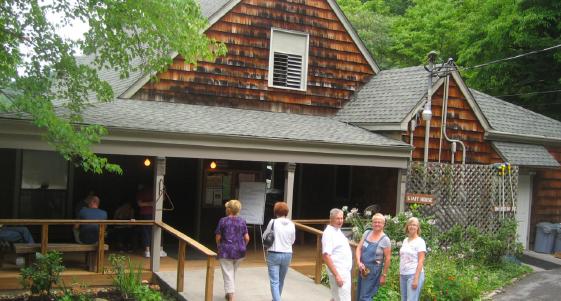
Entrance to Dining Hall
Photo: Carol Barton, August 2011
Workshops began on Sunday evening. While instructors and students drifted in different directions, I returned to my room. Since I was a teaching assistant for a course about Toronto history at Ryerson University, I began marking the few essays that were submitted electronically before the deadline of Monday morning. I turned out the light around 9.00pm and slept well.
Monday 15 November
Knowing that breakfast was served from 8.00 – 8.30am, I set my alarm for 7.20, had a shower and quickly checked my emails. Breakfast was full southern fare, including a choice of fruit, grits (tried once in NC – never again!), scrambled eggs, bacon, sausage, biscuits, oatmeal, pastries, orange juice, tea and coffee. I joined Betty and two woodturners; after the men left, Betty and I got caught up on our respective lives.
When Betty departed for her workshop, I went to the library to wait for Bill Griffith. Bill is a studio artist, administrator and educator at Arrowmont. He was Assistant Director (1987 – 2008), Director of the Artists-In-Residency Program (2006 – 2015), Program Director (2008 – 2015) and Outreach and Partnership Liaison (2016-present). He was given the task of supervising my residency which I expected to spend in the Arrowmont Archives to write about its history. However, Bill said that, in its present on-site location, the archives were not accessible. Instead he proposed that I interview two artists-in-residence who work with wood: Naomi Russo and Kyle Cottier.
Following my meeting with Bill, I took notes on the history of Arrowmont from a wall display in the Turner building and went to Lanny’s classroom where I looked at work in his exhibition catalogs (outstanding!) and talked to him and his students individually. The class had five women and a male work-study student. Several participants were experienced basket makers (they showed me images on their phones) who were at Arrowmont to learn additional techniques; others intended to add wire mesh to their art practice.
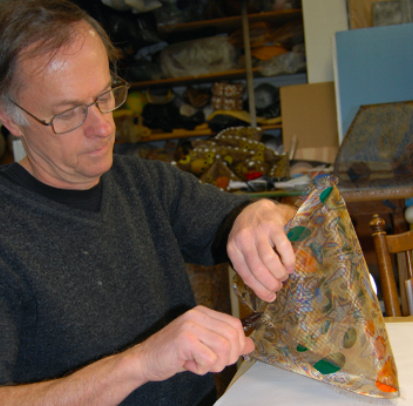
Lanny Bergner, with wire mesh, colored by propane torch
Lunch was catfish, salad and a home-baked peanut butter cookie. Bill introduced me to Kyle and Naomi and I followed them to the artists-in-residence studios. We talked about their work and agreed to meet the following day for taped interviews. Then I stopped by Betty and Dixie’s class where students were using Mastercarver Micro-Pro Champion rotary carvers to create overlaid leaves on a hemispheric wood blank. Dixie did demos using an overhead projector so that all students could observe.
To retain safety in the Covid-19 climate, classes were restricted to six students, all were double vaccinated and wore masks. Arrowmont also housed each participant in a room with private bath.

Dixie Biggs demo: carving of leaf shapes and texturing leaves
Dinner on Monday was baked chicken, red potatoes, saut ed zucchini and chocolate mousse cake. I talked to Tina then returned to my room to mark essays. At 8.00pm the instructors and artists-in-residence were scheduled to give three minutes each to talk about their work. The event was held outside where cold temperatures did not deter riders on the SkyLift from yelling to interrupt presentations. I then made haste to my room, turned up the heater and read myself to sleep.
Tuesday 16 November
I rose at 7.30am and made my way to the dining room for a breakfast of oatmeal with fruit, nuts and maple syrup, biscuit with jam, and decaf coffee. My table companion was a woodturner from Michigan who explained how he’d started: he was gifted with an exercise machine that he thought he’d never use, so the giver exchanged it for a lathe.
Afterwards, anticipating the need for a Covid test for my return to Canada, I phoned American Family Urgent Care in Sevierville to confirm availability and timing.
Then I visited Tina Curry’s class where I talked to her and her students. The first assignment was carving an animal in profile on a clay tile and the second was a three-dimensional animal (chimpanzee, fox, rabbit, gopher). Torsos and heads were created around a paper armature. The hollow core made the piece lighter and it would dry more quickly.Arms (paws) were added once the body was shaped and detailed.
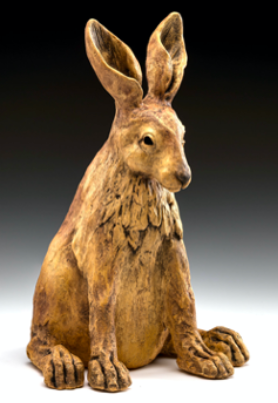
Tina Curry — carved clay jackrabbit
www.curryoriginals.com/gallery
Next I dropped in on a textiles workshop taught by Sonya Philip, the author of The Act of Sewing: How to Make and Modify Clothes to Wear Every Day (Roost Books, 2021). Knowing that some sewers would be daunted by commercial patterns, Sonya’s workshop was devoted to making clothes from simple patterns. Students brought fabric (one used recycled fabrics from thrift shops) to sew blouses, dresses and pants. Most were experienced seamstresses; one, who was an amateur, proudly wore a pair of pants she’d made herself during lunch on the final day.

Sonya Philip
www.100ActsofSewing.com
The final workshop I viewed on Tuesday was ‘Shake and Shoot Powdercoat Two Ways’ delivered by Rachel Shimpock. On Sunday evening and Monday, Rachel had demonstrated powdercoating by two methods – sifting and with a static gun – and I watched students working at their benches or with torches to make bases to be powdercoated.
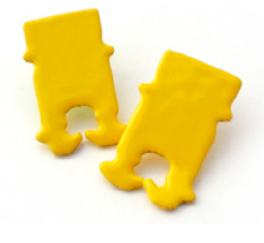
Rachel Shimpock
www.rachelshimpock.com
This image, from Rachel’s website, shows that powdercoating can be applied to anything! Rachel’s portfolio includes bases such as crinkle potato chips. I didn’t see anyone at Arrowmont powdercoating food items but noticed a student named Jackie coating earrings made with scraps of metal mesh from Lanny’s workshop.
Tuesday’s lunch was chicken tacos, a choice of vegetables for salad, and green mousse squares for dessert. After lunch I taped an interview with Naomi Russo in her studio. Naomi has a BFA in Woodworking and Furniture Design from Maine College of Art. Our conversation suggested links to other artists on site so I introduced Naomi to a sewing student who is a kindergarten teacher (Naomi wanted to test her toys and furniture on children) and to Lanny. Kyle Cottier was to have an interview that afternoon, too, but was firing ceramics in a barrel and needed to tend the fire. Kyle earned a BFA from the Art Academy of Cincinnati and works with industrial wood scraps.
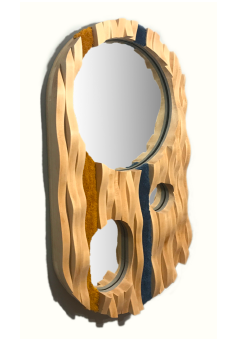
Naomi David Russo, Rote Mirror
www.naomidavidrusso.com
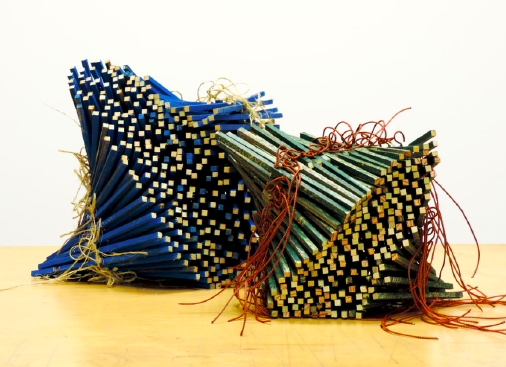
Kyle Cottier, When I am Among the Trees
www.kylecottier.com
I returned to my room and sent emails. I consulted friends employed in woodworking programs about recommendations re graduate schools for Naomi and Kyle; I received approval to write about Tina Curry for Ceramics Monthly. And based on a conversation with Bill, I made a booking for a Covid test on Thursday. Dinner was Swedish meatballs, roast carrots, broccoli/cauliflower salad, and a brownie. That evening I marked essays.
Wednesday 17 November
After an early shower and handwashing ‘smalls,’ my breakfast was orange juice, scrambled eggs, bacon, French toast with fruit sauce, and decaf, during which I chatted with women from Lanny’s class. I then taped an interview with Kyle and revisited the progress of Tina’s students. Tiles were ready to go into the kiln and I watched Tina demonstrate the removal of the paper armature from the interior of an animal sculpture. In the same building was Dietlind Vander Schaaf’s workshop focused on encaustic. I admit I’m more interested in three‑D works than two‑D but I was interested in meeting Dietlind because her bio said she was a writer. I subsequently sent her the name of a book that I thought she’d enjoy: Hannah Kirshner’s Water, Wood & Wild Things.
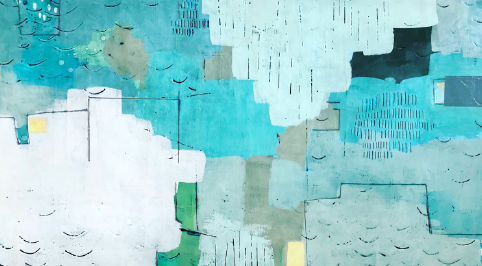
Dietlind Vander Schaaf, All the Clouds in the Sky, 2019
After a brief return to my room to download Kyle’s interview to my laptop, my lunch was salad, sausage, chips and blueberry pie. In the afternoon I scanned several chapters from books in the Arrowmont library and talked to Bill about acquaintances-in-common and his retirement.
At 3.00pm I interviewed Horacio Casillas, another of the artists-in-residence. Horacio has an MFA in ceramics from the University of North Texas and is working on a portfolio that honors his Catholic faith. It includes mugs, urns, holy water fonts, etc., with religious motifs. We had a discussion about whether he should be restrictive in directing his functional ware to a singular faith. Following that I returned to my room to download the interview and complete the ArriveCan form, necessary to return to Canada.
Dinner was Caesar salad, tasty meat lasagne, and a pecan square. Tina and I talked about promoting diversity in craft and then we walked up the hill to visit the Open House for artists-in-residence. Later I taped an interview with Betty and Dixie about their joint teaching gig in woodturning. The two women have been friends for a number of years, phoning each other regularly and meeting up when possible. I enjoyed the informal conversation and warmth of their relationship.
Thursday 18 November
Despite being tired from the long previous day, I woke at 6.15am and became anxious about Covid testing to return home. I checked my emails and then sat alone for a breakfast of orange juice, oatmeal and decaf. I returned to the library to print my ArriveCan form and my article from American Woodturner about Graeme Priddle. Deborah Sosower (Marketing & Communications Manager) met me in the library and took my photo to post that day on Arrowmont’s social media (some attendees told me later that they saw it on Facebook). I then introduced myself to Fran Day (Director of Institutional Advancement). Having just browsed The Haystack Reader: Collected Essays on Craft 1991 – 2009, I asked Fran whether Arrowmont had thought of publishing a monograph about its history. Fran said it had been on her agenda for some time. I gave her the Priddle article and promised to send her my CV and the flyer for my book, Craft is Political. In addition, we shared a few good laughs about Haystack and Maine.
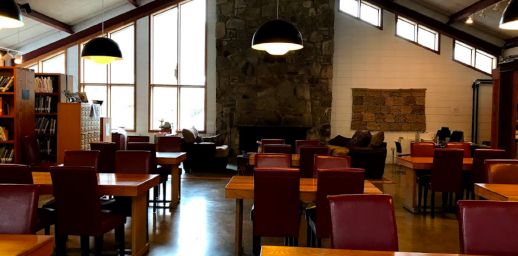
Arrowmont Library
www.arrowmont.org
In Lanny’s workshop, I gave him an update on my pitch for his profile in Metalsmith, as well as observing how his students had progressed. Subsequently I talked to Sonya about her book and admired the array of finished clothing pinned to the workshop walls. Following about an hour in my room, lunch was tuna salad, bread, green salad and pineapple upside down, still warm!
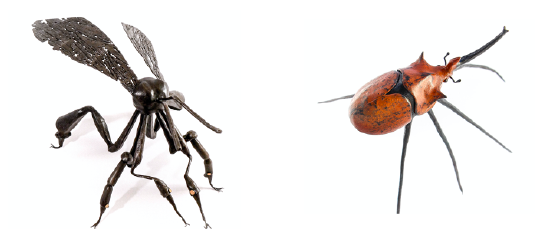
In the afternoon I taped an interview with Elizabeth Belz, a blacksmith and artist-in-residence. As well as making functional metalware like spoons and ladles, she makes insect sculptures. Elizabeth told me that in looking around at objects made by blacksmiths, colors were monochrome and dull so she has been experimenting with patinas that are natural to the bugs.
At 4.20 I met Katie Sharpe, Studio Technician in textiles/metals. She lives in Knoxville and was dropping me off at AFC Urgent Care in Sevierville, for a Covid antigen test. The appointment was at 5.30 and I had my negative results by about 5.50pm. The clinic receptionists then tried to call me a taxi and phoned about eight numbers with no-one answering. I had them call Bill Griffith and he arranged for Elite Taxi to pick me up. The driver arrived at 7.30pm. He was very talkative and I engaged with him until he said that he and his family had had Covid and he subsequently agreed to one vaccination. He wasn’t wearing a mask, whereas I was double-masked. Even so, I worried that he was contagious.
I got back to Arrowmont around 8.00pm with the result that I missed out on two things: dinner, and the walk-about to various studios to see student work. The latter was a loss. I ate snacks that I had in my room and went to bed to read a novel called The Survivors by Alex Schulman (translated from Swedish).
Friday 19 November
After a shower at 7.00am I checked my emails then headed for the dining room for orange juice, fruit, quiche, bacon, tea biscuit and jam, and decaf, talking companionably with Tina.
Horacio had asked me to look at his Cover Letter for a job application so I went to his studio. The letter was well written
and needed only a few tweaks. I went to Tina’s class where I helped her unload tiles from the kiln and looked at the elephants that the students had made since the previous day. One was a Dumbo look-alike with big ears and others were realistically detailed. I was surprised and honored when Tina gave me her tile of a bobcat. I then went to the woodturning studio where students were packing up and being hectored about a group photo. Betty gave me one
of her eggs, something I’ll treasure.
With people gradually disappearing I marked some essays and headed for my final lunch: salad, pizza, and chocolate bread pudding, still warm from the oven. Yummy! I said goodbye to Tina who packed her car to return to Knoxville and pick up her dog from the kennel.
I went into Gatlinburg to see if I’d missed anything on the previous visit. The most interesting spot was a Western boot store where I marveled at the variations in decoration and stitching on women’s boots, obviously another form of craft. The streets were once again crowded on this sunny, mild day and almost no-one wore masks. My own mask drew looks.
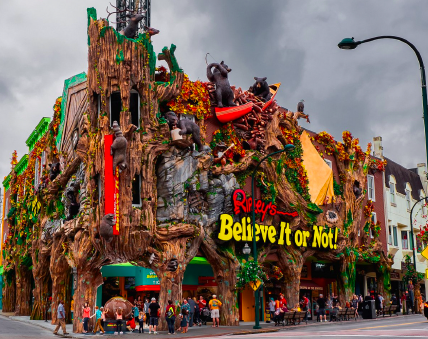
The essence of Gatlinburg, TN
https://www.tripadvisor.ca/Attraction_Review-g60842-d247702-Reviews-Ripley_s_Believe_It_or_Not_Gatlinburg-Gatlinburg_Tennessee.html
I had made arrangements to meet Betty for dinner and returned to the Arrowmont campus to confirm our rendezvous. When I went to my room I found an email saying that she left for home (Indianapolis) shortly after I saw her. I was disappointed and with no-one else around, I stayed in my room for the evening, marking essays and eating snacks. I probably got about three hours sleep.
Saturday 20 November
I set my alarm for 4.00am; got up, washed, dressed and finished packing. Pick-up time dictated by 1‑N-Only Airport Taxi was 4.45am but when no-one arrived I checked my emails. There was a message from the driver saying that the rangers had closed the road through the National Park so he would be at Arrowmont around 6.00am. I waited in my room, was picked up just before 6.00 and arrived at McGhee Tyson Airport at 7.00am for my flight to Charlotte at 8.59am. My breakfast was a feta and spinach wrap and hot chocolate from Starbucks. The flight from Knoxville to Charlotte took 40 minutes.
American Airlines in Knoxville had accepted my negative NAAT Molecular Rapid Testing/DNA antigen test but it was rejected at the departure gate in Charlotte. An intransigent male AA employee would not accept the circumstances* of my test and insisted that I could not board a flight without a PCR test. He gave me the address for a clinic and put me on waitlists for flights the next day. This was unacceptable because it meant staying overnight in the airport. I stopped at an AA Customer Information kiosk where the female representative was considerably more obliging, tried to phone the clinic (no answer) and determined that the place was open on Saturday. She also said there was a flight to Toronto that evening via Miami and if I got back to the airport in time I could be booked on it.
I got a Green Taxi to StarMed Family and Urgent Care. The driver was familiar with the clinic and wasted no time getting there. Coincidentally, the clinic was having a Covid testing event with marquees in an adjacent parking lot
and members of the military giving directions and information. I got a Rapid PCR test – negative results – and the same taxi driver returned to take me to the airport again. I was away for about an hour. Another polite and friendly female AA employee booked me on the Charlotte-Miami-Toronto flight, ensuring that I would not have to pay extra.
The flight to Miami left on time at 4.25pm but the flight to Toronto, supposed to leave at 8.05pm, was delayed by an hour and 20 minutes. I arrived in Toronto at 12.30am on Sunday, by which time the UP Express train into Toronto had stopped running, requiring me to take a limo at five times the cost of the train. I arrived at my home at 1.30am, brushed my teeth and climbed into bed.
Reflections
It was the trip from hell! The meat in the sandwich – 6 days at Arrowmont – made up for the snags in getting there and coming back to Toronto. The pandemic has provoked measures that, depending on your destination, are impossible to comply with and are administered by individuals who are empowered with inadequate information.
I enjoyed meeting artists and students at Arrowmont, a School to which I had not been before. I would certainly recommend Arrowmont for its setting (except the tourism), meals, accommodation and workshops. The reason I have detailed the meals is that pleasant and tasty dining makes for a productive atmosphere in the studio. Chatting over a delicious meal breeds conviviality which extends to the sessions and vice versa. While most people sit with their classmates, ‘strangers’ taking empty chairs are welcomed.
Rather than use the residency for writing I came away with writing assignments. I secured artist profiles for Tina Curry with Ceramics Monthly and Lanny Bergner in Metalsmith. A publication that highlights Naomi Russo and Kyle Cottier to fulfill The Furniture Society component of the residency is yet to be determined. I intend to pitch stories about basket makers I met, as well as approach Ebony about Arrowmont’s African-American instructors and mandate of diversity. My week at Arrowmont was valuable for making contacts for the future.
I want to thank Arrowmont School of Arts and Crafts and particularly Bill Griffith for facilitating my participation and making inquires for Covid testing in the area. I am grateful for the Canada Council for the Arts’s travel grant that has paid for unexpected charges as a result of requirements for travel during the pandemic. And, above all, my sincere appreciation goes to The Furniture Society for giving me the opportunity to visit a School I had long wanted to attend.
*Covid PCR tests must be taken within 72 hours of departure. Results from the Sevierville clinic, where swabs are sent elsewhere for analysis, take 3 to 5 working days. The clinic’s doctor recommended going to Knoxville, where I would find testing at a hospital, but the lack of a vehicle prevented this option. I did the next best thing by having a Covid antigen test and trusted that my explanation for this would be accepted.

D Wood
PhD, MFA, BArch, BA
December 2021
Sponsors:
The Furniture Society
Arrowmont School of Arts and Crafts
Canada Council for the Arts